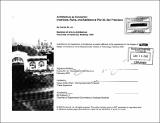| dc.contributor.advisor | Hasan-Uddin Khan. | en_US |
| dc.contributor.author | Lin, Eunice M. (Eunice Mae), 1973- | en_US |
| dc.contributor.other | Massachusetts Institute of Technology. Dept. of Architecture. | en_US |
| dc.coverage.spatial | n-us-ca | en_US |
| dc.date.accessioned | 2012-01-12T19:20:51Z | |
| dc.date.available | 2012-01-12T19:20:51Z | |
| dc.date.copyright | 2000 | en_US |
| dc.date.issued | 2000 | en_US |
| dc.identifier.uri | http://hdl.handle.net/1721.1/68358 | |
| dc.description | Thesis (M.Arch.)--Massachusetts Institute of Technology, Dept. of Architecture, 2000. | en_US |
| dc.description | Includes bibliographical references (p. 168-171). | en_US |
| dc.description.abstract | The thesis addresses the issues of adaptive reuse of Pier 26, one of few remaining pieces of San Francisco's grand maritime heritage. With the city's vision of changing its unused industrial waterfront into a recreational zone, the thesis focuses on the conditions affecting the reuse of the site to achieve this vision. The goal is to investigate how architectural reuse of a building can keep alive history and memory of place in the context of transformation . The investigation occurs at three scales: urban context, site, and building. These scales provide clues to defining reuse strategies and inform the new uses and their overall design concepts. The selected program uses cultural and recreational activities as the appropriate vehicle for revitalization of this edge of the city, in relation to the following nearby developments: the cultural area of Verba Buena - the post-industrial Bohemia areas coexisting with the "Multi-Media Gulch" area - South of Market and the popular recreational Embarcadero Promenade which runs along the waterfront. The program for the building will include artists' studios, recreational facilities and a restaurant. The main tools to achieve this end are based on the strategies for reuse developed in this thesis: insertions, ruins, and additions. The thesis aims to demonstrate how adaptive reuse can address the idea of architecture as connector: connecting the past, present and future through memory and history; connecting uses and different user and social groups; and lastly connecting once separated parts of the city fabric. | en_US |
| dc.description.statementofresponsibility | by Eunice M. Lin. | en_US |
| dc.format.extent | 174 p. | en_US |
| dc.language.iso | eng | en_US |
| dc.publisher | Massachusetts Institute of Technology | en_US |
| dc.rights | M.I.T. theses are protected by
copyright. They may be viewed from this source for any purpose, but
reproduction or distribution in any format is prohibited without written
permission. See provided URL for inquiries about permission. | en_US |
| dc.rights.uri | http://dspace.mit.edu/handle/1721.1/7582 | en_US |
| dc.subject | Architecture. | en_US |
| dc.title | Architecture as connector : insertions, ruins, and additions at Pier 26, San Francisco | en_US |
| dc.type | Thesis | en_US |
| dc.description.degree | M.Arch. | en_US |
| dc.contributor.department | Massachusetts Institute of Technology. Department of Architecture | |
| dc.identifier.oclc | 45009910 | en_US |
